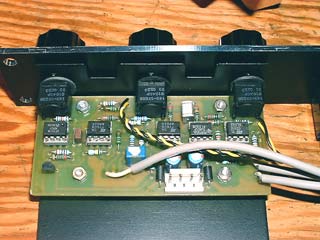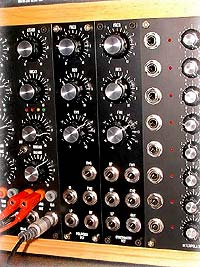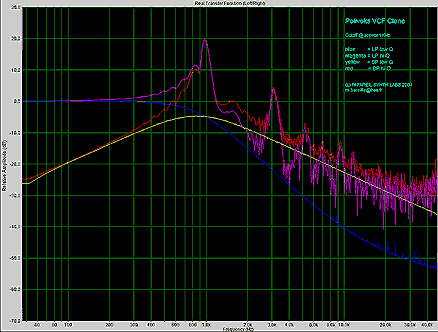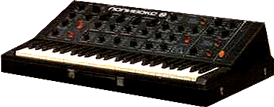
Special
thanks to Allan J. Hall for his great contribution
to this project !
This
filter is a clone of the famous vintage russian analog synthetiser
named  .Inside this synth there is an incredible and very original
filter invented by Vladimir Kuzmin. Please visit
his web site at http://www.muztech.com
. It is a Lowpass ( LP) and Bandpass (BP) voltage controled
filter with a special design and sound . A Vodka filter...The
clone contains only cheap common parts, and it is very simple
to build... No calibration trimmers or accurate tempco stages
required, it is not the spirit of this beast from the far
East ...
.Inside this synth there is an incredible and very original
filter invented by Vladimir Kuzmin. Please visit
his web site at http://www.muztech.com
. It is a Lowpass ( LP) and Bandpass (BP) voltage controled
filter with a special design and sound . A Vodka filter...The
clone contains only cheap common parts, and it is very simple
to build... No calibration trimmers or accurate tempco stages
required, it is not the spirit of this beast from the far
East ...
Unlike
most of Voltage controled analog filters who use a combination
of a fixed capacitor with a variable resistor element (
OTA, opto,etc..) the filter core here is just a pair of
programmable low power operational amplifiers ( PLPOA?).
At first sight, it look like a classic SVF but with a difference:
there is no capacitors ! CV modulations are applied on the
current setting pin (Iset) to reduce or increase the GainBandwith
of the aop who act as a variable time constant RC element.
It is a 12dB filter. Sound as well. A bit wild at extreme
Q, remind a little bit the Korg MS20 on this point . Frequency
modulation on CV inputs work well with this filter!
Schematics
The
vintage schematic has been sligthly adapted to modern
modular synthesizer standarts
-
Added output amplifier-buffer stages for both outputs
with a gain of 11, because the audio level on outputs
is rather low .
- The
vintage filter was powered with +/-12.5V. The clone
can also work under +/-15V .
-
CVs calibrated because programmable aop have a range
for the Iset pin were they work fine.
-
Added
a reversible cutoff frequency CV attenuator (option)
- A fixed
attenuator ( 100k ajustable pot ) added to the audio
input jack to avoid overload -not on the schematic.

Russian
equivalent parts...
European
parts suggested here are working equivalents . The first
reference proposed is the closest from the original ( hacked)
|
Russian
Ref |
Europa/USA
Ref |
Function |
| KR140UD8B |
uA740
, uA741, LF351,... |
Single
standart AOP |
| KR140UD12 |
uA776,
MC1776, LM4250,NTE888 |
Programmable
low power AOP |
| KT315G |
2N3904A |
NPN
transistor |
The LM4250 GainBandwith
vs Iset curve is not exactly the same as the UA776: much
more sensitive ...So both 110K resistors wired on Iset pin
to limit the current flow must be increased at least to
1M ohms. On my prototype ( +/-15V) i have used 1.2MOhm with
a couple of LM4250 in metallic rounded box ... There is
probably some other programmable opamps on the market able
to work here
For the Cutoff
CV amplifier, the vintage russian opamp is a hacked UA740,
but any single op amp will fit well. The NPN transistor
is not very critical too.

This
filter is also is great to process directly external audio
signal ( -10dB) . The addition of a little mixer or a simple
fixed attenuator before the audio input is advised specialy
if you use this filter with hi level modular VCO waveforms,
to avoid permanent overload !


And
the sound ?
Allan,
who was able to do a direct comparison with the Polivoks synthesizer,
report the clone sound very very close from the original.
An electronic clean sound is produced at low Q .The filter
start to self oscillate with the Q pot set over 2/3.The resonance
sound progress with a serie of harmonic steps when the Q pot
value is increased. It is a very musical effect, much accentuated
if the filter is overloaded ! With Q set to max , the sound
suddenly become extremely "harsh" a lot of character...
This filter is less noisy than OTA based filters... Curves
bellow show a spectrum analysis of LP and BP outputs with
Q pot at minimum and maximum with cuttof frequency set at
around 1kHz. Clic on the picture to enlarge .

Here are sample sound of the Polivoks filter. Contribution of Raphael ( Paris-France)
- Warp633 + Polivoks vcf clone - Loop1 (mp3)
- Warp366 + Polivoks vcf clone - Loop3 (mp3)

Polivoks
VCF Clone pcb + Assembly manual
are available on order |

